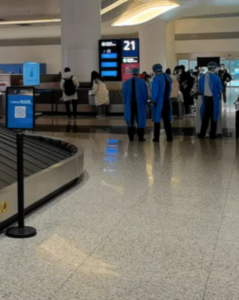
A new phase of living with the new crown: effective protection of populations with a high incidence of severe disease actively promotes the end of the epidemic process
On December 26, 2022, the National Health Commission (NHC) issued an announcement on the 26th, renaming novel coronavirus pneumonia to novel coronavirus infection and adjusting the name from “Category B A control” to “Category B B control” from January 8, 2023, which is a major adjustment of China’s This is a major adjustment in the prevention and control policy of the new coronavirus outbreak.
In addition to the previous “New Ten”, with the lifting of strict isolation measures, the cessation of intensive nucleic acid testing, and the downgrading of the big data trip card, the full liberalization ushered in a large area, high-density infection, but also brought many new troubles: including the sudden arrival of cold and fever medicine, the shortage of antigen detection kits and other unexpected problems, as well as faster than the spread of the virus panic, testing everyone, but also testing the public health and medical The ability of the public health and medical system to cope with the situation is being tested.
On December 27, the Phoenix 2022 International Health Summit, organized by Phoenix.com and hosted by Phoenix Health, was held online. In the roundtable forum “Changes and Challenges: Public Health under Globalization”, Lu Hongzhou, member of the American Academy of Microbiology and president of Shenzhen Third People’s Hospital, Zhang Zuofeng, director of the Department of Epidemiology at the University of California, Los Angeles (UCLA) School of Public Health, and Hao Yuantao, executive director of the Center for Strategic Research on Public Health and Prevention and Control of Major Epidemics at Peking University, were invited to speak with the audience. Hao Yuantao, Executive Director of the Center for Public Health and Strategic Research on Major Epidemic Prevention and Control, Peking University, and Sun Xuemei, Deputy Editor-in-Chief of Phoenix.com and General Manager of National Government, together with moderator Sun Xuemei, will discuss the rationality behind the panic and anxiety, and explore the new path of epidemic prevention and control in the new stage, taking into account the lessons learned from the initial liberalization at home and abroad.
“Liberalization” is not “lying flat”, and special attention needs to be paid to those who are susceptible to serious illnesses
There are many reasons for those who are eager to “liberalize”, such as the low virulence and low lethality of the new strain of Oncoron, and the gradual return to normal life after the earlier liberalization outside China. However, the widespread infections that emerged in China after the liberalization caused a relatively large impact on the public health and medical system and required an active response.
Based on China’s huge population base, how do we meet the unexpected layers of challenges?
According to Lu Hongzhou, the Omicron variant strain is indeed weak in pathogenicity and low in lethality, but extremely contagious. In Taiwan, a country with a population of nearly 30 million, for example, the number of deaths so far this year is 14,800, mainly among the elderly, people with underlying diseases and immune deficiencies.
For the mainland, due to the huge base of infection, the number of people who are likely to become seriously ill is definitely not a small number, especially the 267 million elderly people who are prone to serious illness and death, as well as the immune-deficient population, including more than 50 million cancer patients, for whom the earlier proper protection is implemented, the better it is to reduce the risk of serious illness and death.
“The primary protection measure is vaccination. At present, China has received more than 3.46 billion doses of vaccines, and the vaccination rate is very high.” However, according to Lu Hongzhou, the willingness to vaccinate is still weak among people over 80 years old, and vulnerable groups such as tumor patients and immunodeficient people are still not ensured to avoid infections and serious illnesses after vaccination. For people who are prone to serious illness, they should take small molecule drug treatment regimens at the early stage of infection and not wait for them to develop serious illness before treating them. Either domestic or imported small molecule antiviral treatment drugs, or antiviral treatment with monoclonal antibodies or a combination of two monoclonal antibodies can play a certain preventive role and effectively avoid their development into severe disease.
Zhang Zuofeng emphasized the need for intensive vaccination. He believes that although most of the Chinese population has been vaccinated, 90% of them were completed last year and have exceeded the validity period of 5-6 months to resist the virus, including 50% of the vaccination booster population also completed before March this year, and the protective effect has basically declined. He suggested that the second booster vaccination should be universalized as soon as possible.
In fact, new vaccines with higher levels of protection and the convenience of more widely available vaccination are being accelerated or have already been approved. Lu Hongzhou’s Shenzhen Third People’s Hospital has been involved in evaluating the effectiveness and safety of several vaccines this year. He said that the previous two years of vaccination in China were mainly inactivated vaccines, and 13 products, including recombinant protein vaccines and adenovirus vector vaccines, have been approved for marketing, and there will be nucleic acid vaccines and mRNA vaccines in the future. We found in clinical trials that the six mRNA vaccines and recombinant protein vaccines that will be marketed in the future are more effective.
In addition, in the future, there will be vaccines that are effective, have few side effects and can obtain long-term protective effects, universal vaccines, such as the domestic peptide nasal spray vaccine, which can make the respiratory tract produce effective mucosal immune protection and epithelial cell immune protection of the respiratory tract. “Even if we inhale the virus, the virus cannot replicate in our body.”
Zhang Zuofeng also mentioned that the prerequisites for liberalization of outbreak prevention and control are very low virulence, widespread proportional vaccination, and, of course, an adequate stockpile of clinical oral medications. This includes both general drugs for cough and fever, and clinical new crown treatment oral drugs to stop the seriousness of the disease. On the one hand, it can reduce deaths, and on the other hand, it can facilitate treatment at home and avoid the crowding of medical resources. Countries such as South Korea and Singapore have gradually liberalized strict prevention and control only under the condition of stockpiling sufficient oral therapeutic drugs, and have liberalized travel only after six months of coexistence with the virus. Therefore, he suggested that the production or import of clinical oral drugs should be accelerated.
Optimize prevention and control strategies for the new phase to ensure that the epidemic moves toward the end in the desired course
Under the new stage of coexistence with the virus, based on the previous waves of epidemics caused by the constant mutation of the new crown virus, people are undoubtedly most concerned and worried about what kind of disease the new crown may become in the future, whether it will face secondary infection down the road, whether it will bring about repeated epidemics, etc.
Zhang Zuofeng believes that the so-called mutation of the new crown virus is basically saturated with the current variant of Omicron, which is the main infection, and there will rarely be a worse mutation variant. The next most likely mutation may be more infectious, but it will also be relatively less virulent. Because I heard that the strain popular in the north is called BF.7, including the possibility of BQ.1 or BQ.1.1 and other so-called “hellhounds” in the future, it sounds quite scary. But in fact, this new strain has already become prevalent in other countries and regions, including Japan and the United States, and from the existing cases, it is still basically the Omicron subtype. The rumor that it will come once every two months is basically impossible. The key is to protect yourself better after infection before antibodies are formed in your own body.
To avoid recurrence of the epidemic, individual efforts and optimal adjustment of government prevention and control strategies are indispensable, and the challenge remains. Professor Zhang Zuofeng said that only when “the risk of neo-crown is reduced to about the same level as influenza, can we say that this neo-crown epidemic has turned from a pandemic to an endemic.”
Hao Yuantao said that the epidemic will inevitably recur, “reminding us to have a lot of plans and preparations, in some places, local also need to do the corresponding optimization of the prevention and control policy adjustment.” He suggested that the current situation is, first, to quickly make relevant plans and preparations around the world; second, to do a good job of health education and communication, so that the public can understand the changing situation of the epidemic, correctly understand the disease and strengthen personal health literacy; third, to improve the medical treatment system for patients with serious and critical illnesses.
He especially emphasized that under the situation of abolishing the full nucleic acid test, it is necessary to optimize the monitoring indicators and methods, and strengthen the early warning of disease monitoring by multiple paths, especially focusing on the monitoring indicator system in terms of the infected population and the severity of the disease, the stockpiling and use of hospital supplies, the variation of the virus, and the response to public concerns, as well as to achieve more transparent and accurate information.
For the treatment of patients with large infections, Lu Hongzhou suggested that a graded treatment system should be done, so that patients with minor illnesses stay in primary hospitals and ensure that patients with serious illnesses can be transferred to designated hospitals, tertiary hospitals and general hospitals for treatment in the first place.
Reducing serious illnesses and mortality is the core responsibility of the medical system and the last hope of patients, but hospitals and doctors are currently under heavy pressure and are also key areas for optimization and improvement. Lu Hongzhou believes that medical personnel at all levels should first of all do a good job of protection according to the prescribed program and avoid working with diseases; secondly, according to national regulations, designated hospitals should have 10% of medical equipment, doctors and nurses to treat seriously ill patients, and 10% more critical beds in case of emergency; again, medicine is also the main battlefield of science and technology to fight against epidemics, and we should speed up clinical trials of drugs and vaccines, develop new diagnostic programs, medical instruments and equipment, and contribute to the scientific and technological fight against epidemics. We should speed up clinical trials of drugs and vaccines, develop new diagnostic protocols, medical instruments and equipment, and contribute to the power of science and technology to fight the epidemic.
Zhang Zuofeng especially emphasized that the goal of zero epidemic prevention and control should be translated into zero serious illnesses and deaths.


Average Rating